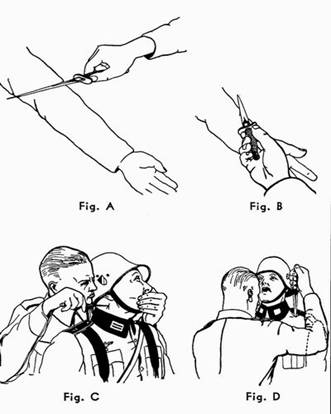|
From “All-in fighting” by W .E. Fairbairn 1942
|
 |
|
NO. 28-USE OF THE KNIFE In close-quarters fighting there is no more deadly weapon than the knife. An entirely unarmed man has no certain defence against it, and, further, merely the sudden flashing of a knife is frequently enough to strike fear into your opponent, causing him to lose confidence and surrender. In choosing a knife there are two important factors to bear in mind: balance and keenness. The hilt should fit easily in your hand, and the blade should not be so heavy that it tends to drag the hilt from your fingers in a loose grip. It is essential that the blade have a sharp stabbing point and good cutting edges, because an artery torn through (as against a clean cut) tends to contract and stop the bleeding. If a main artery is cleanly severed, the wounded man will quickly lose consciousness and die. The Fairbairn-Sykes Fighting Knife (shown on the opposite page) developed by the author and a colleague, is highly recommended as possessing the requisite qualities. This knife and similar tyres have round wide favour among experts. There are many positions in which the knife can be carried. Selection of this position depends upon individual preference based on length of arm, thickness of body, etc. The following considerations, however, should always be borne in mind. A quick draw (an essential in knife fighting) can not be accomplished unless the sheath is firmly secured to the clothing or equipment. Moreover, speed on the draw can be accomplished only by constant daily practice. The author favours a concealed position, using the left hand, for in close-quarters fighting, the element of surprise is the chief ingredient of success. Certain arteries are more vulnerable to attack than others, be- cause of their being nearer the surface of the skin, or not being protected by clothing or equipment. Don't bother about their names so long as you can remember where they are situated. In the accompanying diagram (Fig. 112), the approximate positions of the arteries are given. They vary in size from the thickness of one's thumb to that of an ordinary pencil. Naturally, the speed at which loss of consciousness or death takes place will depend upon the size of the artery cut. The heart or stomach, when not protected by equipment, should be attacked. The psychological effect of even a slight wound in the stomach is such that it is likely to throw your opponent into confusion. Method of Making the Gut Artery #1. Knife in the right hand, attack opponent's left anI1 with a slashing cut outwards, as in Fig. A. Artery #2. Knife in the right hand, attack opponent's left wrist, cutting downwards and inwards, as in Fig. B. Artery #3. Knife in right hand, edges parallel to ground, seize opponent around the neck from behind with your left anI1, pulling his head to the left. Thrust point well in; then cut sidewaY3. See Fig. C. Artery #4. Hold knife as in Fig. D; thrust point well in downwards; then cut. Note.-This is not an easy artery to cut with a knife, but, once cut, your opponent will drop, and no tourniquet or any help of man can save him. Heart # 5. Thrust well in with the point, taking care when attacking from behind not to go too high or you will strike the shoulder blade. Stomach #6. Thrust well in with the point and cut in any direction. Note.-If knife is in left hand, when attacking arteries #1 and #2. reverse the above and attack opponent's right arm. |
|

